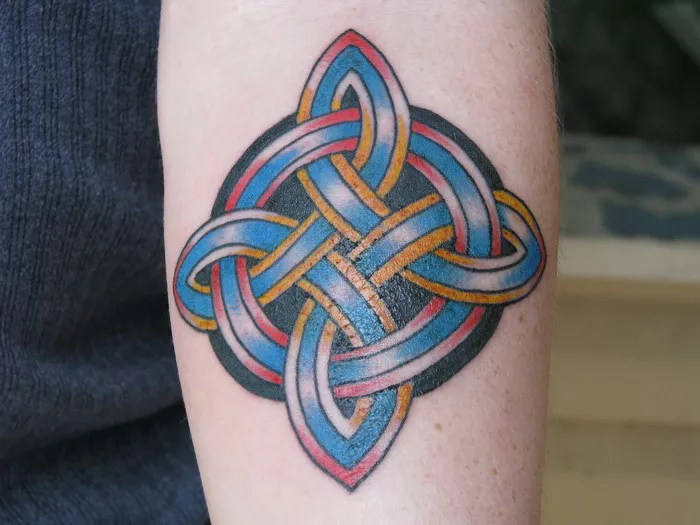Celtic tattoos have long captured the imagination of enthusiasts, adorned with intricate patterns and symbols that carry profound meanings. Among the various elements that contribute to the allure of these tattoos, one question frequently arises: Why are Celtic tattoos predominantly blue? This inquiry delves into the rich historical, cultural, and symbolic significance of the color blue within Celtic art, shedding light on its deeper implications and resonances.
The Historical Tapestry: Tracing the Origins of Celtic Art
To comprehend the prevalence of blue in Celtic tattoos, it is imperative to explore the historical context from which these designs emerged. The Celts, an ancient Indo-European people, flourished across Europe during the Iron Age, leaving behind a legacy of art, language, and mythology. Central to Celtic culture was their distinctive artistic expression, characterized by intricate knotwork, spirals, and interwoven patterns.
In ancient Celtic society, blue held a special significance, symbolizing various aspects of their worldview and spirituality. The Celts revered nature, attributing sacred qualities to natural elements such as water, sky, and earth. Blue, as the color of the sky and water, embodied these divine connections, representing concepts of purity, spirituality, and transcendence.
The Power of Symbolism: Understanding the Significance of Blue
Within Celtic mythology and symbolism, blue carried multifaceted meanings, each contributing to its prominence in art and tattoos. One prevalent interpretation associates blue with the Otherworld, a realm believed to exist beyond the physical world, inhabited by gods, spirits, and mythical creatures. In Celtic lore, the Otherworld was often depicted as a mystical realm shrouded in blue hues, signifying its ethereal and enigmatic nature.
Moreover, blue held associations with the supernatural and the divine. Deities such as the Morrigan, goddess of war and fate, and Lugh, the skilled craftsman and warrior god, were often depicted with attributes of blue, underscoring its connection to spiritual forces and cosmic energies.
Additionally, blue symbolized concepts of protection and guidance within Celtic belief systems. The famous Blue Eye motif, featuring a blue-colored eye surrounded by intricate patterns, was believed to ward off evil spirits and provide spiritual protection to the bearer. This protective symbolism resonated deeply with the Celts, who adorned themselves with talismans and amulets imbued with spiritual significance.
The Alchemy of Color: Exploring the Materials Behind Celtic Blue
Beyond its symbolic connotations, the prevalence of blue in Celtic art can be attributed to the materials available to ancient artisans. The Celts employed natural pigments derived from minerals, plants, and organic sources to create vibrant colors for their artwork. One of the primary sources of blue pigment was indigo, extracted from the leaves of the indigo plant through a labor-intensive process.
Indigo dyeing techniques were known to ancient civilizations across the globe, including the Celts, who utilized this precious pigment to adorn their textiles, pottery, and body art. The intricate knotwork and patterns of Celtic tattoos were often embellished with shades of blue, reflecting the craftsmanship and artistic mastery of the period.
Furthermore, the Celts had access to other natural sources of blue pigment, such as woad, a plant native to Europe that yielded a deep blue dye when processed. Woad played a significant role in Celtic society, not only as a pigment for art and tattoos but also as a symbol of cultural identity and resilience.
The Legacy Endures: Modern Interpretations of Celtic Blue Tattoos
While the ancient Celts primarily used blue in their artwork for symbolic and practical reasons, the tradition continues to resonate in modern Celtic tattoos. Contemporary tattoo artists draw inspiration from Celtic motifs and symbolism, infusing them with personal meaning and artistic flair.
Blue remains a popular choice for Celtic tattoos, retaining its association with spirituality, protection, and cultural heritage. Whether depicted as intricate knotwork, stylized animals, or mythical symbols, blue hues continue to evoke the mystique and allure of ancient Celtic art.
Moreover, advancements in tattooing techniques and pigments have expanded the creative possibilities for Celtic blue tattoos. Artists can now achieve a wide range of blue shades, from deep indigos to vibrant turquoise, allowing for greater customization and expression.
In conclusion, the prevalence of blue in Celtic tattoos can be attributed to a confluence of historical, cultural, and symbolic factors. From its roots in ancient Celtic mythology to its practical use in artistic expression, blue holds a profound significance within the tapestry of Celtic art and symbolism. As enthusiasts continue to embrace the timeless allure of Celtic tattoos, the enigmatic blue remains an enduring symbol of spiritual connection, cultural heritage, and artistic expression.

